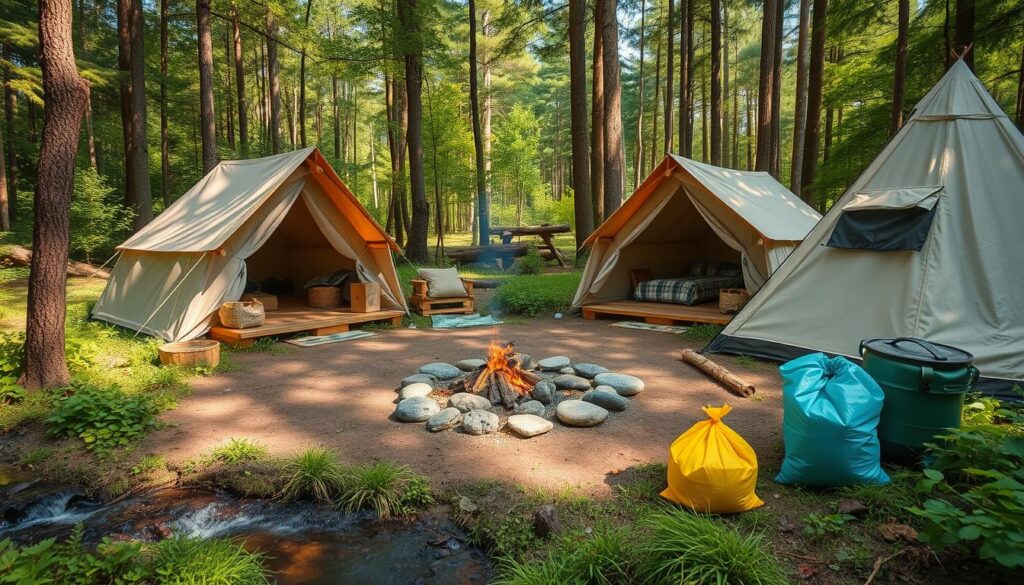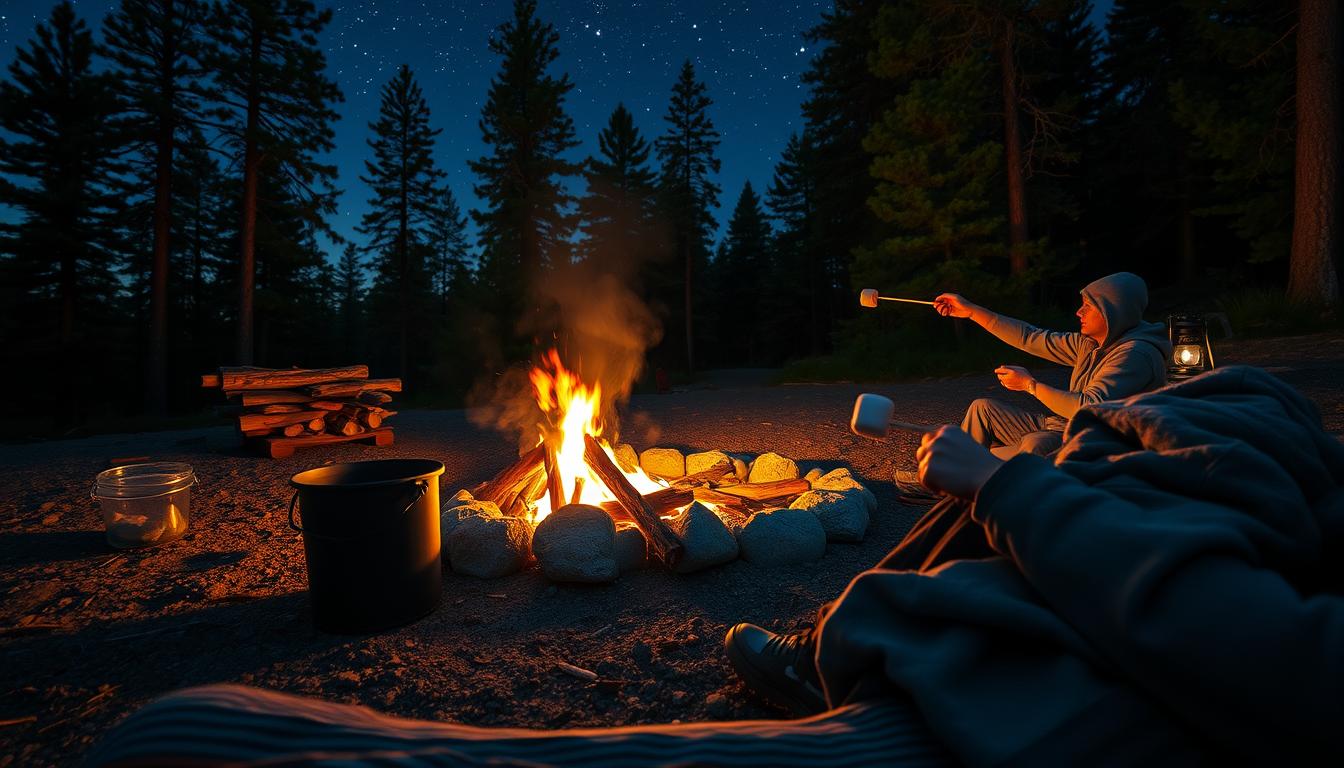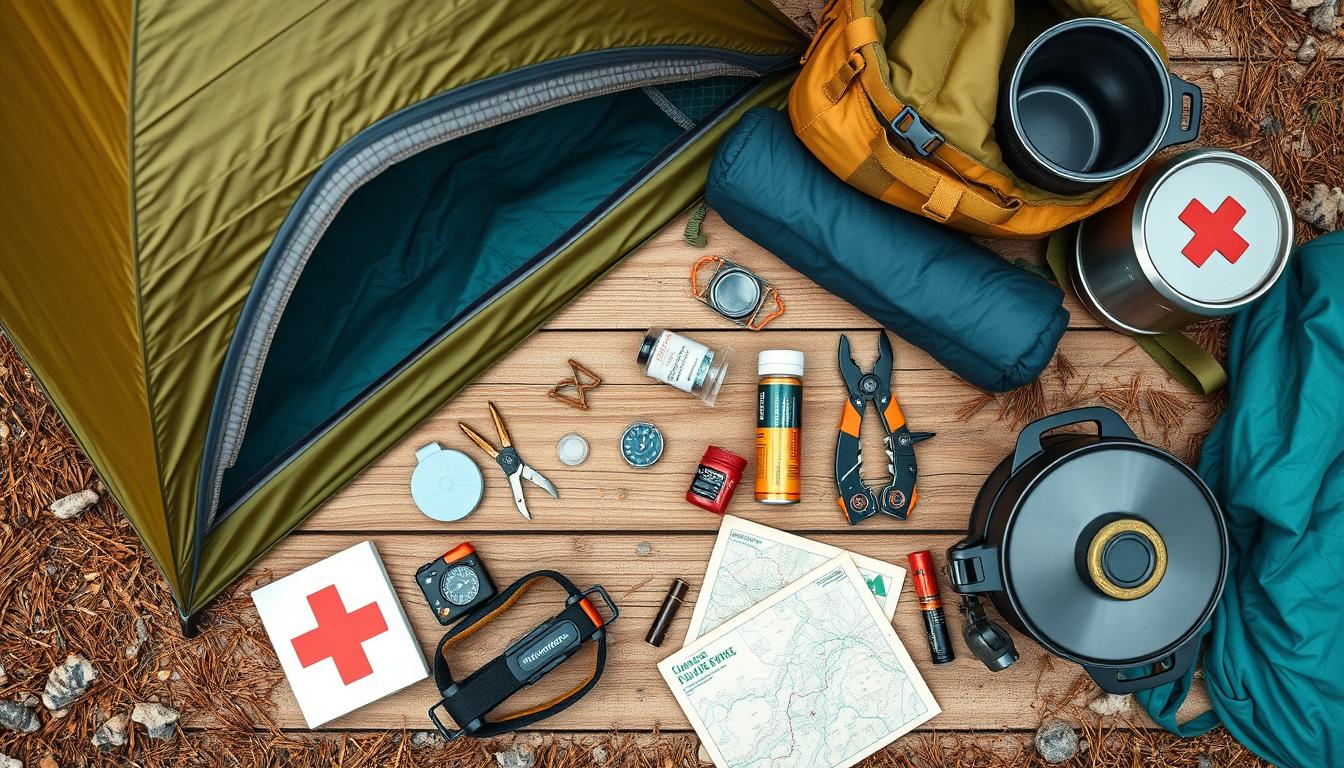I love spending time in nature, and camping is a great way to do it. To keep the outdoors beautiful, we must camp in an eco-friendly way. Learning how to camp sustainably and leave no trace is key to protecting our planet. This article will give you tips on how to camp in a way that’s good for the environment and makes your trip better.
Key Takeaways
- Eco-friendly camping promotes environmental preservation.
- Understanding principles of Leave No Trace is crucial.
- Sustainable camping tips can enhance your outdoor experience.
- Choosing eco-friendly campsites helps protect nature.
- Using renewable resources minimizes camping impact.
- Waste management techniques are vital for sustainability.
Understanding Eco-Friendly Camping
Going on eco-friendly camping means we care about the planet and enjoy nature. It’s about being green and responsible. With climate change and pollution, it’s key to camp in a way that doesn’t harm the environment.
This kind of camping aims to balance enjoying nature with taking care of it. It’s about leaving as little mark as possible. Following the Leave No Trace principles helps a lot. For instance, planning your trip and picking the right campsite can help avoid damage.
Also, being kind to wildlife and other campers makes the trip better. Simple things like handling waste well and protecting nature are crucial. These actions help me live more sustainably and enjoy nature responsibly. By learning about sustainable camping, I understand how my actions affect the planet.
Embracing eco-friendly camping makes my outdoor adventures richer and more meaningful. Reflecting on my camping habits shows me how important these principles are. Every trip becomes a chance to help the planet.
Benefits of Sustainable Camping Practices
Choosing sustainable camping is more than just fun; it’s good for our planet. It helps keep wildlife and their homes safe for the future. This way, we ensure that nature stays healthy for all campers to enjoy.
One big plus is less pollution. Sustainable camping means making smart choices about waste and resources. This helps protect our environment and makes camping better for me. Clean places help me connect with nature more deeply.
Also, sustainable camping brings people together. Groups like the National Park Service work with others to care for our spaces. This teamwork makes camping a shared adventure, building strong bonds and respect for nature.
Here’s a look at how sustainable camping stacks up against regular camping:
| Impact | Sustainable Camping | Conventional Camping |
|---|---|---|
| Wildlife Preservation | Minimal disturbance to local ecosystems | Potential harm through littering and pollution |
| Environmental Impact | Reduced carbon footprint and waste | Higher levels of trash and energy consumption |
| Community Engagement | Collaborative conservation efforts | Isolation and lack of shared responsibility |
By using sustainable camping, I feel closer to nature and help protect it. Every trip becomes a chance to make a difference and enjoy the journey responsibly.
How to Camp Sustainably and Leave No Trace
Camping lets us connect with nature, but we must be responsible. Learning to camp sustainably and leave no trace is key. It makes our experience better and protects nature for others. Knowing the leave no trace principles helps us camp responsibly.
Embracing the Leave No Trace Principles
The leave no trace principles have seven main guidelines. They help us enjoy camping while being kind to the environment. Here are the seven principles:
- Plan ahead and prepare.
- Travel and camp on durable surfaces.
- Dispose of waste properly.
- Leave what you find.
- Minimize campfire impact.
- Respect wildlife.
- Be considerate of other visitors.
By following these principles, we can reduce our impact. This shows respect for nature and personal responsibility.
Choosing Eco-Friendly Campsites
Choosing eco-friendly campsites is important for sustainable camping. I look for sites that are good for the environment and fun. Here are some tips for picking eco-friendly campsites:
- Proximity to water sources—avoid camping directly near lakes or rivers to protect water quality.
- Established campsites—utilizing existing sites reduces damage to new areas.
- Location away from sensitive habitats—choose sites that do not disrupt wildlife and vegetation.
- Accessibility to facilities—reduce the need for extensive infrastructure by selecting sites with adequate amenities.
I check with the Leave No Trace Center for Outdoor Ethics for top eco-friendly campsites. They help me find sites that follow sustainable practices.

| Leave No Trace Principle | Description |
|---|---|
| Plan ahead and prepare | Ensures safety and minimizes impact by understanding regulations and conditions. |
| Travel and camp on durable surfaces | Protects fragile environments by camping on established trails and sites. |
| Dispose of waste properly | Avoids pollution by packing out trash, leftover food, and litter. |
| Leave what you find | Preserves the natural environment by not disturbing cultural or natural features. |
| Minimize campfire impact | Reduces the risk of wildfires and ecological disruption by using stoves. |
| Respect wildlife | Encourages minimal interaction with animals and protects their habitats. |
| Be considerate of other visitors | Fosters a pleasant experience for all by respecting others’ space and noise levels. |
Essential Sustainable Camping Tips
When I plan my camping trips, I focus on sustainable tips. These tips make my trip better and protect the environment. I choose eco-friendly campsites that care for nature.
I try to use public transport to cut down on carbon emissions. If that’s not possible, I carpool with friends. This way, we all help the planet. At the campsite, I do activities that don’t harm wildlife or the environment.
Reducing waste is key for me. I pack things that can be reused or recycled. I also use biodegradable products like soaps and utensils. This way, I make sure I leave no trace.
It’s important to follow campfire rules. I check if campfires are allowed and follow the guidelines. Using only fallen wood helps protect the forest.
| Tip | Description |
|---|---|
| Plan Ahead | Choose eco-friendly campsites and research local regulations. |
| Use Public Transport | Opt for buses or trains to minimize carbon emissions. |
| Pack Light | Bring reusable items to reduce waste. |
| Follow Campfire Rules | Check regulations and use downed wood only. |
| Practice Responsible Outdoor Etiquette | Stay on trails and respect wildlife habitats. |
By following these sustainable camping tips, I enjoy nature more. I also help keep it safe for others in the future.
Eco-Friendly Gear and Equipment
Choosing the right gear is key to sustainable camping. The gear we pick can greatly affect the environment. So, I look for eco-friendly options that support conservation and sustainability.
By making smart choices, we can start to live greener. This is especially true for our outdoor adventures.
Choosing Green Camping Gear
I search for camping gear made from sustainable materials. Many brands now offer eco-friendly options. This way, my choices don’t harm the planet.
Brands like Patagonia and REI make products from recycled or organic materials. This reduces waste and supports renewable resources.
- Look for gear made from recycled plastics or organic cotton.
- Consider biodegradable or compostable products for cooking and dining.
- Choose equipment that is designed for longevity to reduce the frequency of replacement.
Using Renewable Resources
Using renewable resources makes camping even more sustainable. I use solar-powered gadgets for light and charging. This cuts down on nonrenewable energy use.
Choosing organic camping supplies also helps. It means fewer harmful chemicals and supports fair farming.
By focusing on sustainable gear, camping becomes better for both me and the planet. It shows my dedication to preserving nature for the future. Choosing eco-friendly gear positively impacts the environment and enhances my outdoor experiences.
Minimizing Environmental Impact While Camping
When I go camping, I always try to leave the environment as I found it. Using good waste management is key to keeping nature clean. By following the rules, I help protect the beautiful places we visit.
Waste Management Techniques
Using the right waste management techniques helps us enjoy nature without harming it. Here are some important steps I take:
- Packing out trash: I make sure to take all trash, including food and packaging, back with me.
- Leave-no-trace methods: For human waste, I use biodegradable bags and bury it at least six inches deep. This keeps things clean and safe for the environment.
- Composting: If I can, I compost organic waste. This returns nutrients to the soil and reduces waste.
Water Conservation Strategies
Conserving water is crucial for both my camping trip and the local water sources. Here are some easy ways to do it:
- Responsible water usage: I only use water when I really need it, for cooking and cleaning up.
- Purifying water: If I need to use water from nature, I use filters or purification tablets to keep it clean.
- Short showers: If I have access to a shower, I try to keep it short to save water.

By using these waste and water-saving tips, I help protect our environment. Following the Leave No Trace guidelines shows how important it is to camp responsibly.
Sustainable Outdoor Activities to Enjoy
Doing sustainable outdoor activities makes camping better and helps the planet. Each activity helps us connect with nature and care for it. Here are some fun and rewarding options:
- Hiking: Nature trails show off the landscape’s beauty and are good for the earth. I stick to paths to avoid harming the soil and keep plants and animals diverse.
- Wildlife Spotting: Watching animals in their homes teaches us about ecosystems. I use binoculars to get a closer look without disturbing them.
- Low-Impact Fishing: Catch and release fishing helps fish populations and keeps water ecosystems healthy. It’s a fun way to enjoy fishing while caring for the environment.
These activities make me love nature more and want to protect it. They show me the importance of camping in an eco-friendly way. By enjoying these moments, I hope to inspire others to care for the outdoors too.
Eco-Conscious Camping Tips for Families
Family camping is a great way to connect with nature and teach kids about caring for the environment. By following eco-conscious camping tips, families can show kids the importance of protecting our planet. Making campouts fun and educational helps kids love and respect nature.
Engaging kids in nature activities is a great way to make camping eco-friendly. I love doing nature scavenger hunts with my kids. It lets them explore and learn about the plants and animals around us. This hands-on learning makes them curious and teaches them to protect our ecosystem.
Working together on waste management is key. I involve my kids in sorting waste, teaching them about recycling and reducing waste. We also have a family cleaning ritual at the campsite. It teaches everyone to be responsible and helps keep our campsite clean.
Choosing eco-camps can make your camping trip even better. These camps focus on teaching kids about conservation and environmental awareness. It’s a great way to bond as a family and create lasting memories that inspire kids to love nature.
Here’s a handy table of eco-conscious camping tips tailored for families:
| Activity | Description | Benefits |
|---|---|---|
| Nature Scavenger Hunt | A fun activity involving searching for specific natural items. | Encourages exploration and appreciation of local wildlife. |
| Waste Sorting Game | Kids sort items into recycling, compost, or trash bins. | Teaches responsibility and the importance of proper waste management. |
| Eco-Friendly Crafts | Use natural or recycled materials to create crafts. | Inspires creativity while promoting sustainability. |
| Visit Eco-Camps | Attend camps focused on sustainability and conservation. | Builds a lasting love for the environment through immersive experiences. |
Conclusion
Exploring eco-friendly camping shows it’s not just a choice, but a duty we all have. The leave no trace principles help us protect nature while enjoying it. By following these rules, we help keep our outdoor spaces safe for the future.
In this article, I shared tips on eco-friendly camping. It’s about choosing the right gear and managing waste and water. Every small action helps. I’m inspired to make these choices part of my outdoor adventures.
The heart of sustainable camping is working together. By choosing eco-friendly camping, we show respect for nature. This way, we can enjoy the outdoors while keeping it beautiful for others.





Leave a Reply